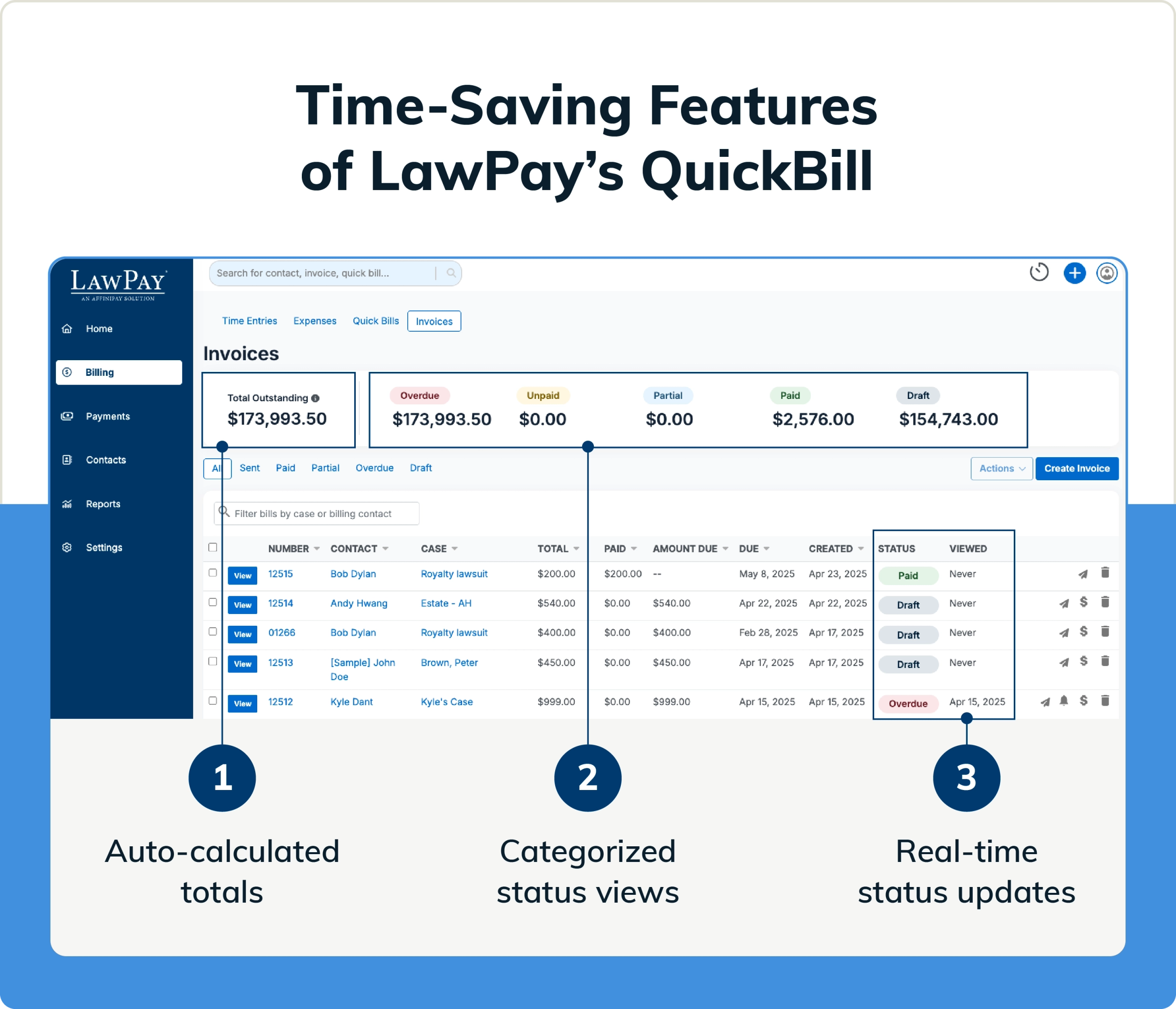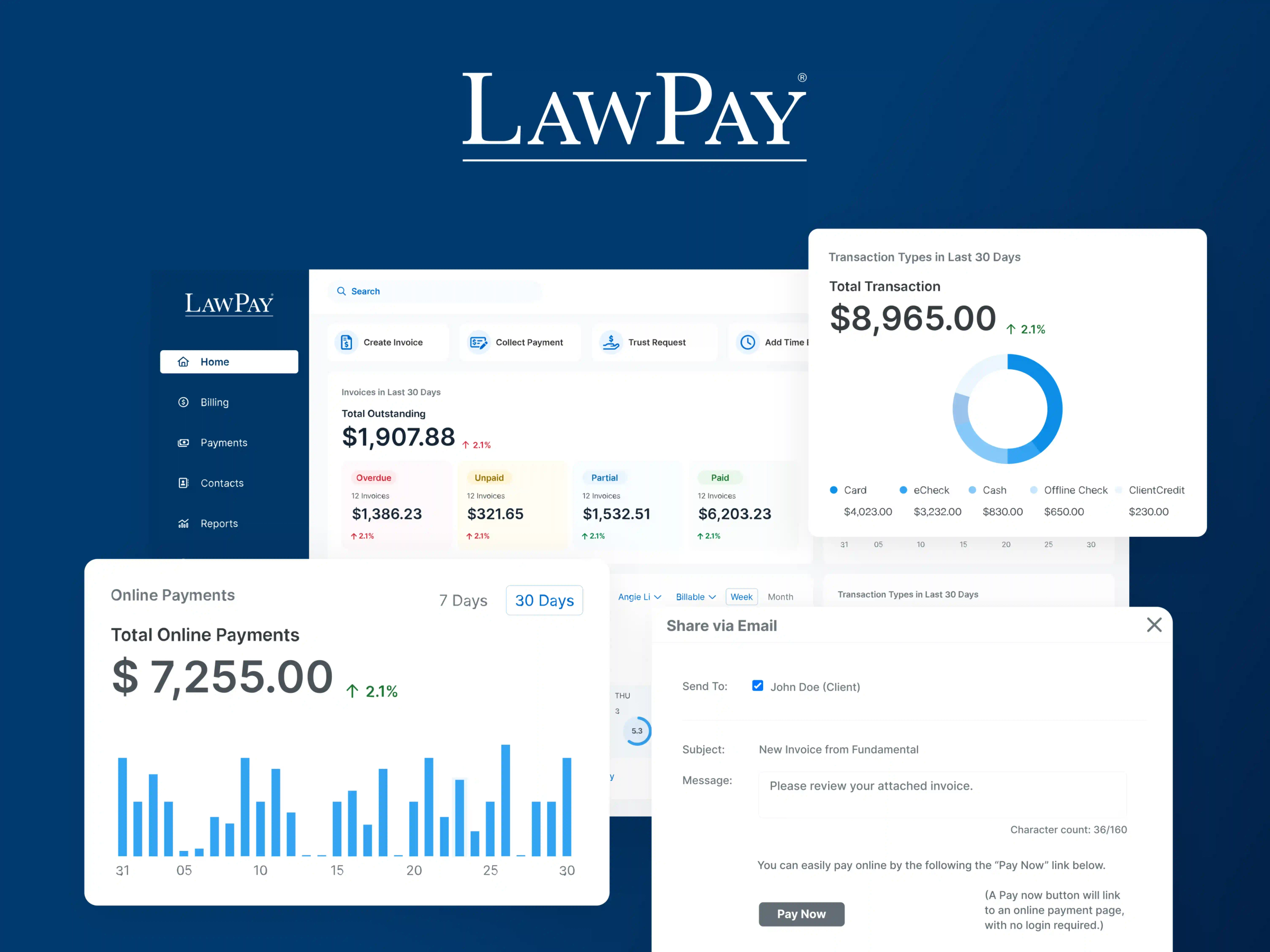For mid-sized organizations, the foundation of any effective billing system is a streamlined invoice management system tailored for law firms. However, according to our 2025 Legal Industry Report, 53% of law firms identified invoicing clients as a top financial management challenge. And these challenges stem from several key factors.
Many mid-size law firms use outdated billing processes that don’t support the flexible payment that today’s legal consumers demand. In addition, collecting invoices creates its own challenges, with some attorneys spending more time tracking down payments than on billable hours.
The good news is that an efficient, modern billing system can improve profitability and ensure the invoicing process scales with growing law firms as their needs evolve. In this article, we'll go over steps mid-sized legal firms can take to enhance their invoice management workflow, common invoicing challenges, the benefits of a streamlined invoicing approach, and key software features that can support mid-sized firms.
How Mid-Sized Legal Firms Can Improve Their Legal Invoicing Process
The key to establishing proper cash flow management for a mid-sized law firm is through an efficient invoicing process. Effective invoice management for legal firms makes it easier for your firm to bill clients, control recovery costs, and get paid quicker. Below are five steps to help mid-size law firms improve their current invoicing system.
1. Evaluate the Current Invoicing Process
Before determining what you need to fix, start by evaluating your current invoicing process. This review will cover every aspect of your firm’s invoicing, from time tracking to final billing. As part of this evaluation, also analyze your firm’s current fee structures and see whether you can implement more flexible billing arrangements in the payment process.
As you conduct your review, be mindful of the red flags that reflect underlying challenges in your firm’s invoicing process. These include:
Delayed legal invoice creation that takes weeks or months to send to clients
Slow payments from clients or a high percentage of overdue invoices
Inaccurate or forgotten time tracking
Confusing or unclear billing structures
Time-consuming tasks that bog down the invoicing process
Gathering direct feedback from staff and clients is also valuable as part of the review process. The billing staff can highlight the pain points they want addressed during the invoicing overhaul. Similarly, clients can articulate challenges or burdens ingrained in your billing process and suggest improvements.
2. Revisit Your Law Firm’s Financial Goals
After reviewing your current invoicing process, the next step is to review your firm’s financial goals. Financial goals your firm fails to reach may be directly tied to a flawed element of the invoicing process.
For example, if your firm sets a goal to prioritize maximizing your billable vs. non-billable hours, you can take measures to ensure that your attorneys log time accurately. If the firm’s rate of billable hours is below the forecast, the underlying reason may be that attorneys are having trouble completing their time-tracking duties or struggle to track their time accurately.
3. Standardize Templates and Processes
Standardizing the invoicing process and templates is an effective way to reduce errors and accelerate the completion of billing cycles. Some of the methods mid-sized law firms may approach for this task can include:
Creating a standard invoice template using common billing language appropriate for all clients.
Establishing internal standards for how lawyers track billable hours and creating a system of accountability when attorneys do not meet these expectations.
Maintaining a document database that includes templates and policies for all elements of the invoicing process in a place that all staff can easily access.
As you overhaul templates and processes, executing standardized training for the entire team is also important. Hosting team-wide trainings ensures all stakeholders receive the same information and carry out the work with the same expectations. Alongside these trainings, your team can create a standard operating procedure (SOP) and other documentation that serve as a source of truth for current and future staff.

4. Incorporate Technology and Automation
There is no shortage of software in the market that helps legal firms manage invoices. It’s crucial to identify solutions that are comprehensive enough to meet your firm's needs, while also seeking features that support growth as your firm continues to scale.
For example, LawPay’s QuickBill dashboard lets users quickly view an invoice’s payment status (e.g. paid, partially paid, overdue), the client’s engagement with each invoice, and the auto-calculated dollar amount totals for each of these categories. Users can also quickly sort or filter bills based on these statuses to prioritize collections and follow-up efforts.

In addition to scrutinizing individual features, it’s also helpful to prioritize all-encompassing practice management software to streamline your firm’s unique workflows as your staff continues to balance client and administrative needs.
Below are a few tips to keep in mind when evaluating legal software solutions:
Investigate integration capabilities to ensure that the platform can seamlessly work with the existing tools your team needs to keep. Ask vendors about how data synchronization works and to share examples or live demos of those integrations in action.
Assess the platform’s customization and scalability to see if the platform can fit with both your current workflow and projected future growth. You can look at customization options for invoice generation, reporting, and user permissions based on your firm’s needs.
Review client self-service features that can help reduce your firm’s administrative burden as you continue growing your client base. Look for features like client portals, secure payment pages, and communication features that help centralize information.
Evaluate training and support resources that can help your firm quickly adopt the platform. Access to responsive customer support and robust help centers can help ease the transition, especially if your firm does not have a dedicated IT team that can help with day-to-day questions.
5. Evaluate Changes, Collect Feedback, and Adjust
After implementing updates to the invoicing process, look back at the changes made with an objective eye. To effectively evaluate progress, consider the following tips:
Establish clear metrics for success and analyze financial reports to spot trends. For example, if your team’s goal was to improve the realization rate, you may evaluate metrics like the number of billing disputes in a month or the average number of days to collection.
Conduct formal surveys with staff to gather feedback. You can use rating scales to easily compare factors like satisfaction or ease of use between periods. The survey can also include open-ended areas for the team to share comments, thoughts, or suggestions.
Solicit feedback from clients through direct conversations, anonymous surveys, or a mix of both to understand their pain points, feedback, or praise for changes in the invoicing process.

Common Invoicing Challenges for Mid-Sized Legal Firms
Invoice management for mid-sized legal firms can come with its share of challenges. Some of the most common challenges may include:
Manual or outdated systems and tools that are difficult to use or take unnecessary labor hours to resolve.
Staff members who resist change and want to continue doing things the same way they always have.
Budgeting issues that may make it hard to justify upgrading software or investing in additional resources that would otherwise improve the invoicing process.
Siloed data transparency that limits the ability of key stakeholders to make decisions and communicate effectively with clients.
Lack of standardization that create complexity and uncertainty during every phase of the invoicing process.
Delayed invoicing that can result in clients who are not billed for weeks or months, delaying collections.

Benefits of Efficient Invoicing for Mid-Sized Firms
The fundamental benefit of a more efficient invoicing system for mid-sized legal firms is that the billing cycle is resolved faster, allowing law firms to get paid more quickly. Faster payment leads to a handful of benefits, ranging from improved operational effectiveness to stronger client relations
These translate into specific advantages for mid-sized firms, including:
Shorter billing processes that can improve cash flow and reduce reliance on credit lines.
More time spent on billable hours rather than chasing accounts or resolving invoicing issues.
A streamlined and transparent payment process that fosters trust with clients.
Greater visibility into the financial health of the law firm’s operations, allowing key stakeholders to make better strategic planning decisions.
An established scalable billing process that adapts to a growing firm.
Key Invoicing Software Features for Mid-Sized Legal Firms
Improved invoice management for mid-sized legal firms starts with a solid workflow, but an all-in-one software platform can further enhance efficiency and accuracy. Consider these features when selecting an invoicing solution:
Workflow automations: Automed invoicing helps bills go out to clients quickly, eliminating costly delays that prevent you from collecting promptly. Additionally, automated payment reminders for unpaid invoices ensure clients receive regular touchpoints that help encourage quicker repayment.
Vital billing and invoicing insights: Receive a complete picture of outstanding invoices, accounts receivable balances, and team productivity.
Time tracking and expense management tools: Lawyers can receive prompts to track time every time an email is sent, a phone call is logged, or a document is uploaded. Precise time tracking means precise invoice management without losing billable hours through human error.
Streamline Your Law Firm’s Invoice Management with LawPay
Invoice management for law firms is a crucial issue that mid-sized law firms should address. Invoice management for mid-sized legal firms touches almost every part of the organization. A poor billing system can reduce revenues, delay collections, and erode trust between you and your clients.
A comprehensive billing platform resolves these issues by streamlining the invoicing process, automating administrative tasks, and making it easier for attorneys to log their billable hours. This saves mid-sized law firms time, gets them paid faster, and creates a better customer experience.
See how LawFirm’s comprehensive legal billing software can improve your firm's invoicing processes. Schedule a demo today and see LawPay in action.
Schedule a demo to see what LawPay can offer your firm.
Book Now
About the author

Esther ParkContent Writer
Esther Park is a content writer and Senior SEO Manager for leading legal software companies, including MyCase, Docketwise, and CASEpeer, as well as LawPay, the #1 legal payment processor. Her expertise lies in writing about emerging legal technologies and financial wellness strategies for law firms, among other topics.
